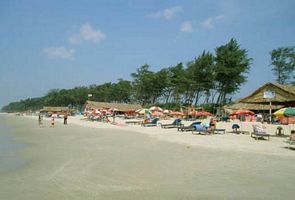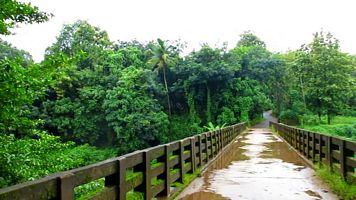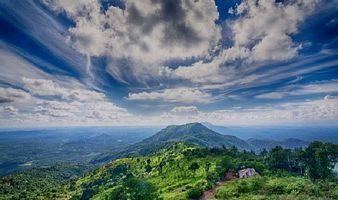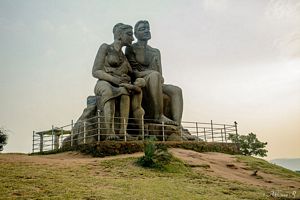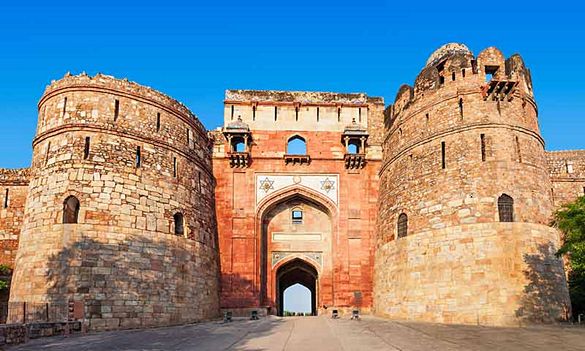
New Delhi, the capital of India, is famous all over the world for its political activities. New Delhi is not only famous for its politics but it is also known all over the world for its interesting history and historical monuments. Siri Fort, located in the Indian capital New Delhi, is one of the oldest forts in India, the remains of which can still be seen here.
Red Fort
The Red Fort is one of the most famous historical buildings of India. The Red Fort was built by the fifth Mughal king Shah Jahan in 1648 AD. It took 10 years to complete. This fort is located in Old Delhi. This fort was decided by Shah Jahan in 1638 after changing his capital from Agra to Delhi, after which the Red Fort was built. The Red Fort derives its name from the red sandstone used in its construction. The fort is known for its impressive architecture, which combines Mughal, Persian, and Hindu styles. The Red Fort is closed on every Monday, on other days the Red Fort is open from 9:30 am to 4:00 pm. There is a ticket to enter the Red Fort (Facts of Red Fort), which you can take online or offline, if you take online ticket, then you will get 40 rupees each and offline ticket then each ticket 50 will have to be paid. At the same time, admission is free for children below 15 years of age.
- How to reach: The Red Fort is located in Old Delhi, and the nearest metro station is Chandni Chowk on the Yellow Line. From there, you can take a rickshaw or a cycle rickshaw to reach the fort. Alternatively, you can also take a cab or an auto-rickshaw.
- Best time to visit: The best time to visit the Red Fort is between October and March when the weather is pleasant, and the skies are clear. The fort is open from 9:30 am to 4:30 pm, and it is closed on Mondays.
Adilabad Fort
Adilabad, a fort of modest size built on the hills to the south of Tughlakabad, provided a large protective rampart on the border around the city of Jahanpanah. The fort was much smaller than its predecessor, Tughlaqabad Fort, but was of similar build. The Archaeological Survey of India (ASI) in its assessment of the condition of the fort for conservation has recorded that two gates etc. Between two bastions in the south-east and a barbaric in the south-west with a barbaric inside, it, separated by a bailey, is a bastion consisting of walls, bastions and gates. The Adilabad Fort was also known as 'Muhammadabad' but was estimated as a development of a later day. The two gates to the south-east and south-west of the Adilabad fort were the chambers on the lower level while the east and west gates had grain boxes and courtyards on the upper storey. The linked fortifications with the other two city walls were 12 meters (39.4 ft) in length and up to 8 km (5.0 mi) in length. Another smaller fort, called Nai-ka-Kot (literally "Barber's Fort") was also built about 700 meters (2,296.6 ft) from Adilabad with bastions and army camps, which is now Only seen in ruins.
- How to reach: The fort is not easily accessible by public transport, and visitors may need to hire a taxi or take a private car to reach the fort.
- Best time to visit: The best time to visit the fort is during the winter season from November to February when the weather is pleasant.
Najafgarh Fort
Najafgarh is a city in South West Delhi district in the National Capital Territory of Delhi, India. It is one of the three subdivisions of South-West Delhi district. Najafgarh is located on the outskirts of the south-western part of Delhi near the Haryana border, 29 kilometers (18 mi) from New Delhi city centre.
Old Fort
Purana Qila, also known as Old Fort, is another significant fort in Delhi that dates back to the 16th century. The fort was built by the Mughal emperor Humayun and was later renovated by Sher Shah Suri. The fort is known for its impressive architecture and the beautiful lake that surrounds it. The fort has several structures within its complex, including the Qila-i-Kuhna Mosque, Sher Mandal, and the Archaeological Museum. It is located in the Indraprastha area of Delhi. The fort has three big gates and the walls of the fort are 18 meters high. At the same time, there is a mosque in the premises of Purana Qila, which was constructed with the contribution of two emperors. Purana Qila is open from 6:00 am to 6:00 pm. There is a ticket to enter Purana Qila, which you can take online or offline, which will cost you Rs. At the same time, admission is free for children below 15 years of age.
- How to reach: Purana Qila is located in South Delhi, and the nearest metro station is Pragati Maidan on the Blue Line. From there, you can take an auto-rickshaw or a cab to reach the fort.
- Best time to visit: The best time to visit Purana Qila is between October and March when the weather is pleasant. The fort is open from 7:00 am to 5:00 pm, and it is closed on Fridays.
Quila Rai Pithora
Qila Rai Pithora has the distinction of being the first of the seven cities of Delhi, which was built between 1180-1186 and is related to the great Rajput ruler Prithviraj Chauhan. The last Hindu royal family of Delhi belonged to Rai Pithora. It is noteworthy that Someshwar's son Prithviraj Chauhan established a strong central authority in Delhi as the last Hindu emperor. Vigraharaja's grandson Prithviraj III, known as Rai Pithora and who has been a popular hero of the stories of resistance against the Muslims, expanded Lal Kot by building huge stone ramparts and gates around it. It is famous as the first city fort of Delhi, Rai Pithora. Rai Pithora's Delhi had twelve gates, but Amir Timur has given their number as ten. Some of these opened outwards and some inward. The remains of Rai Pithora fort can still be seen from Mehrauli to Press Enclave.
Salimgarh Fort
Tourists can come here if you want to see the fort of Salimgarh, but it is a bit difficult to reach here. The reason for this is that the way to reach this fort is from inside the Red Fort. When you reach Chhatta Bazar Chowk via Red Fort and turn left towards the museum, the road leads to Salimgarh. Those who go with their mind to see this fort, only they can reach here. The Salimgarh Fort, located in Old Delhi, is quite old as well as interesting and wonderful, so this fort has been included in the list of World Heritage Site by UNESCO. This world famous historical and wonderful fort was built in the year 1546 AD by Islam Shah Suri, the ruler of Suri dynasty established in Delhi. Islam Shah Suri was the son of Sher Suri, the most famous ruler of the Suri dynasty.
Sher Shah Suri had established the Suri dynasty in the year 1532 AD and after some time in the year 1540 AD by defeating the Mughal emperor Humayun in the battle of Bilgram and established his sultanate in Delhi. The rule of the Suri dynasty lasted for about 17 years in Delhi and after Humayun's return to India in the year 1556 AD, after defeating Adil Shah Suri in a battle, he erased the name of the Suri dynasty and re-established the Mughal Empire in Delhi. Open throughout the year, but usually from 10:00 AM to 5:00 PM daily. There is no entry fee to visit the fort, it is open to all. It takes about 40 minutes to see this huge structure. To reach Salimgarh Fort, you have to land at Delhi's Indira Gandhi International Airport. Also, to reach the fort, you can also take the help of local buses from various places in the city, either by metro, auto or rickshaw or taxi, you can also reach the fort. Near the fort is the Kashmere Gate metro station, while the nearest one is the Old Delhi railway station.
Salimgarh Fort, located on the banks of the Yamuna River, is one of the oldest forts in Delhi. It was built in the 16th century by the Mughal emperor Shah Jahan and was used as a prison during the British Raj. Today, the fort is a popular tourist attraction and a favorite spot for history buffs.
- How to Reach: Salimgarh Fort is located near the Red Fort in Old Delhi and can be reached by taxi, bus, or metro. The nearest metro station is the Delhi Gate Metro Station on the Violet Line.
- Places to Visit Near: Some of the nearby places of interest include Red Fort, Jama Masjid, Chandni Chowk, and Raj Ghat.
- Things to Do: Visitors can take a guided tour of the fort's interior, explore the nearby markets, and enjoy a boat ride on the Yamuna River.
- Best Time to Visit: The best time to visit Salimgarh Fort is during the winter months (October to March) when the weather is pleasant and cool.
Siri Fort
Siri Fort is just 5 kms from the North-East of Qutub Minar near Delhi. Alauddin Khilji is considered to be the greatest emperor of the "Khilji dynasty" because he had extended his dominance in southern India and established another city named Siri in Delhi. Alauddin Khilji built this fort in the 13th century to protect the Delhi Sultanate from Mongols attacks. Due to the ever-increasing Mongol influence in West Asia, the Seljukos sought refuge in Delhi from Alauddin Khilji, which was also accepted by Khilji. The architects of the Seljuk dynasty are credited with creating the architectural monuments of this era in Delhi. This fort was one of the largest forts in India, which is about 1.7 sq.km. was spread over an area of It is believed by some historians that it was the first city that was built by Muslims in an oval shape.
- How to reach: The nearest metro station is Hauz Khas, which is on the Yellow Line. The fort is approximately 2.5 km from the metro station.
- Best time to visit: The best time to visit the fort is from October to March when the weather is pleasant.
Tughlaqabad Fort
This fort is located in Delhi and is just 8 kilometers away from Qutub Minar. Tughlaqabad Fort is a ruined fort in Delhi, built in 1321 by Ghiyas-ud-din Tughlaq, the founder of the Tughlaq dynasty of Delhi of the Delhi Sultanate of India, as he founded the third historical city of Delhi, which was later renamed in 1327. was abandoned. It gives its name to the nearby Tughlaqabad residential-commercial area as well as the Tughlaqabad institutional area. Tughlaq also built the Qutb-Badarpur road, which connected the new city with the Grand Trunk Road. The road is now known as Mehrauli-Badarpur Road. Nearby is the Asola Bhatti Wildlife Sanctuary, Dr. There is also Karni Singh Shooting Range and Okhla Industrial Area.
- How to reach: Tughlaqabad Fort is located in South Delhi, and the nearest metro station is Tughlaqabad on the Violet Line. From there, you can take an auto-rickshaw or a cab to reach the fort.
- Best time to visit: The best time to visit Tughlaqabad Fort is between October and March when the weather is pleasant. The fort is open from 7:00 am to 5:00 pm.
Feroz Shah Kotla Fort
Feroz Shah Kotla Fort was built in the 14th century by the Delhi Sultan Feroz Shah Tughlaq. It was once the capital of the Tughlaq dynasty, and served as a citadel and palace for the rulers. The fort is home to several structures, including a mosque, a baoli (stepwell), and a palace.
- How To Reach: To reach Feroz Shah Kotla Fort, you can take the Delhi Metro to the Pragati Maidan station, and then hire a taxi or take an auto-rickshaw to the fort. Alternatively, you can take a bus to the ITO bus stop, which is located near the fort.
- Best Time To Visit: The best time to visit Feroz Shah Kotla Fort is between October and March, when the weather is cool and pleasant. The fort is open to visitors from 9:00 am to 7:00 pm every day, except on Mondays.
Jahanpanah Fort
Jahanpanah Fort was built in the 14th century by the Delhi Sultan Muhammad bin Tughlaq. It was once the capital of the Sultanate of Delhi, and served as a refuge for the people during times of war. The fort is home to several structures, including a mosque, a tomb, and a palace.
- How To Reach: To reach Jahanpanah Fort, you can take the Delhi Metro to the Saket station, and then hire a taxi or take an auto-rickshaw to the fort. Alternatively, you can take a bus to the Saket bus stop, which is located near the fort.
- Best Time To Visit: The best time to visit Jahanpanah Fort is between October and March, when the weather is cool and pleasant. The fort is open to visitors from 9:00 am to 6:00 pm every day, except on Mondays.
Shahjahanabad Fort
Shahjahanabad Fort, also known as the Old Fort, was built by the Mughal emperor Shah Jahan in the mid-17th century. The fort was built on the site of the ancient city of Indraprastha, which is believed to be the capital of the Pandavas in the epic Mahabharata. The fort is made of red sandstone and has three gateways. The fort is surrounded by a moat, which is now dry. There are several structures inside the fort, including a mosque, a palace, and a stepwell.
- How to reach: The nearest metro station is Pragati Maidan, which is on the Blue Line. The fort is approximately 2 km from the metro station.
- Best time to visit: The best time to visit the fort is from October to March when the weather is pleasant.
Shergarh Fort
Shergarh Fort is located in the Shergarh area of Delhi and is believed to have been built by Sher Shah Suri in the mid-16th century. The fort was built to protect Delhi from the Mughals. The fort is made of red sandstone and has four gates. The fort is surrounded by a moat, which is now dry. There are several structures inside the fort, including a mosque, a palace, and a baoli (stepwell).
- How to reach: The nearest metro station is Shadipur, which is on the Blue Line. The fort is approximately 3.5 km from the metro station.
- Best time to visit: The best time to visit the fort is from October to March when the weather is pleasant.
Alai Darwaza
Alai Darwaza is a gate located in the Qutub Complex in Mehrauli. It was built by the Khilji dynasty ruler Alauddin Khilji in the 14th century as the entrance to the Qutub Minar complex. The gate is known for its intricate carvings and beautiful architecture.
- It is easily accessible by public transport, and visitors can take a metro or bus to reach the Qutub Complex.
- The best time to visit the Alai Darwaza is from November to February.
Jahaz Mahal
Jahaz Mahal is located in the Mehrauli Archaeological Park near the Qutub Minar complex. It was built in the 14th century by the Lodi dynasty ruler, Sikander Lodi. The palace has a unique boat-like structure, which is believed to have been used for entertainment purposes. The palace is now in ruins, but visitors can still see the beautiful architecture and intricate carvings.
- The palace is easily accessible by public transport, and visitors can take a metro or bus to reach the Qutub Complex.
- The best time to visit Jahaz Mahal is from November to February.
Safdarjung's Tomb
Safdarjung's Tomb, located in the heart of Delhi, is one of the most beautiful and well-preserved tombs in the city. It was built in the late 18th century by the son of Safdarjung, a powerful statesman during the Mughal era. The tomb is an excellent example of the architectural style of that period, combining Mughal, Persian, and Indian elements.
- How to Reach: Safdarjung's Tomb is located in the Safdarjung area of Delhi and is easily accessible by road, metro, or taxi. The nearest metro station is the Safdarjung Metro Station on the Yellow Line.
- Places to Visit Near: Some of the nearby places of interest include Lodhi Art District, India Habitat Centre, National Museum, and India Gate.
- Things to Do: Visitors can explore the beautiful gardens surrounding the tomb, take a guided tour of the tomb's interior, and enjoy a picnic with family and friends.
- Best Time to Visit: The best time to visit Safdarjung's Tomb is during the winter months (October to March) when the weather is pleasant and cool.
Quick Links About Forts In Delhi
| S.No | Title | Location |
| 1 | Old Fort | Delhi |
Romantic Getaways: Top Honeymoon Destinations Near Delhi
Discover a curated list of the most romantic honeymoon destinations just a short journey from Delhi. Our guide highlights a range of serene hill stations, tranquil retreats, and luxurious resorts,
Top 9 Wholesale Shoe Markets in Delhi: A Haven for Footwear Lovers
Delhi, a city renowned for its vibrant markets, is a hotspot for footwear lovers seeking quality, variety, and affordability. In this article, we explore the top 9 wholesale shoe markets

Nightlife in Delhi: Discovering these best places to visit in Night in Delhi ..
Discover the pulsating nightlife of Delhi with our comprehensive guide. From trendy bars to lively clubs, immerse yourself in the vibrant atmosphere of Delhi's nightlife scene. Get insider tips, recommendations,

Dilli Haat
Dilli Haat is not just a market; it's a celebration of India's diverse cultures, crafts, and cuisines. Plan your visit to this cultural hub, and you're sure to be captivated
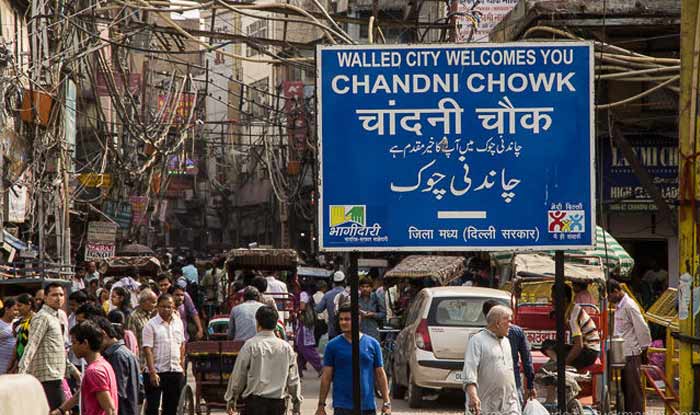
Chandni Chowk
Chandni Chowk, one of Delhi's oldest and busiest markets, is not just a shopping destination but a historical marvel that encapsulates the very essence of the city's cultural and commercial

Garden Of Five Senses
Another romantic place in New Delhi is the garden of five sense. This place is located in the Saidul Azeb area. Anyone who visits this place finds praise from its unrivalled landscape

Kalkaji Temple
Kalkaji temple located near Nehru Place is one of the most visited ancient and revered temples in India. It is also known as Manokamna Siddha Peeth. It says that the

Air Pollution in Delhi: Steps How to control and Effective Strategies and Solutions

National Capital Region (NCR) in Delhi

15 Best Places To Visit in Delhi You must see on Your Next Trip in 2024!!
Delhi, one of the four major metros in the country, tops the top 10 tourist destinations. There are glorious history buildings, monuments, forts, gardens and busiest markets and roads that
- Attractions
-
- Amusements Parks in Delhi
- Art Galleries in Delhi
- Forts & Monuments in Delhi
- Museums in Delhi
- Gardens in Delhi
- Stadiums in Delhi
- Fairs in Delhi
- Shopping in Delhi
- Forts & Monuments in Delhi
- Religious Places in Delhi
- Red Fort
- India Gate
- Rashtrapati Bhawan
- Lotus Temple
- Humayun's Tomb
- Qutub Minar
- Akshardham Temple
- Jantar Mantar
- Rajghat
- Delhi Metro
- Parliament House
- Jama Masjid
- Iskon Temple
- Nightlife Clubs in Delhi
- Chandni Chowk
- Usefull Link
-
- Districts in Delhi
- Banks in Delhi
- Pincode of Delhi
- Best Places in Delhi
- Temples in Delhi
- Places To Visit in Delhi
- Blood Bank in Delhi
- Hospitals in Delhi
- Apple Store in Delhi
- Weekend Getaway From Delhi
- Picnic Spots Near Delhi
- Haunted Places in Delhi
- Water Parks in Delhi
- Chief Ministers of Delhi
- Delhi Travel Guide
